Kingdom Animalia contains large number of animals with various form and size. But there are certain fundamental features common to all the animals. Classification of Kingdom Animalia is based upon these fundamental characteristics, which include arrangement of cells, body plan, body symmetry, nature of coelom, body segmentation, and patterns of digestive, circulatory, reproductive and development systems.
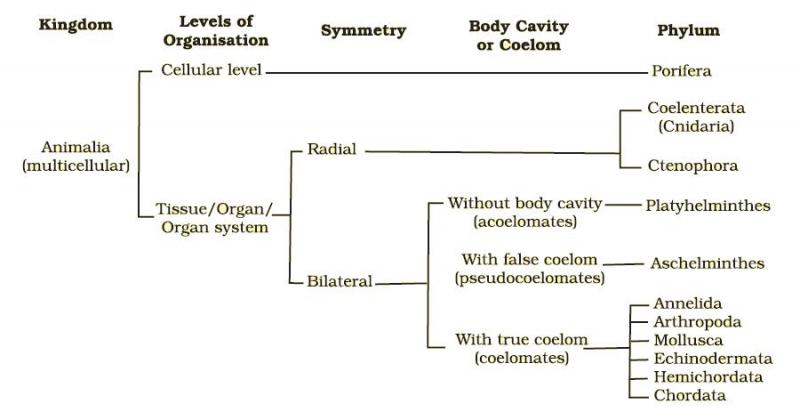
LEVEL OF ORGANISATION
All members of Kingdom Animalia are multicellular. But the arrangement of cells within the body differs in each group. Four patterns of cellular organization are observed in animals.
- Cellular level of Organization: The cells are arranged loosely (as aggregates) in the body. Eg: Sponges.
- Tissue level of Organization: There is division of labour among the cells. A group of cells take up a particular function in the body of the organisms, such group of cells with a particular function is known as a tissue. Eg: Jelly fish (Coelenterates).
- Organ level of Organization: In higher animals, tissues are grouped into organs in the body. Each organ has specific functions. Eg: Platyhelminthes.
- Organ systemlevel of Organization:In all the other animals, organs associate together to form organ systems, each with a specific physiological function. Eg: Arthropods, Annelids, Echinoderms and Chordates.
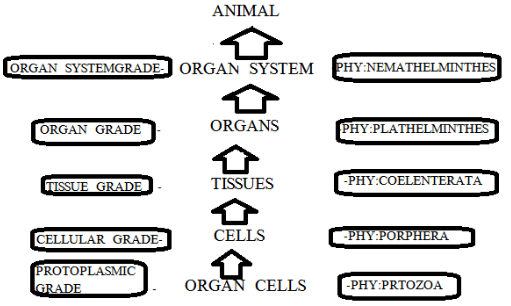
BODY PLAN
Animals exhibit three types of basic body plan nor body organization.
- Cell aggregate plan: The body will have cellular level of organization. Cells will exist as loose aggregates in the body and are not grouped. There will not be much differences in the cells, and division of labour is not present. Eg: Sponges.
- BlindSac body plan: There will be only one opening in the body, which is also the only opening for the alimentary canal. Both food ingestion and waste excretion take place through this opening. Eg: Coelenterates, Flatworms.
- Tube within tube body plan: The body (alimentary canal) has two openings. Mouth for taking food, and anus for excretion. The alimentary canal (inner tube) lies within a body cavity called coelom (outer tube). Eg: Annelids and all Chordates.
BODY SYMMETRY
External body of an animal can be symmetrical or asymmetrical.
Asymmetrical animals cannot be divided into equal halves along any plane of division. Upon division, they form dissimilar halves. Eg: Sponges.
Symmetrical animals can be divided into two equal halves.
- Bilateral Symmetry: The animal can be divided into two equal halves along a specific plane of division. Eg: Frog, Human.
- Radial Symmetry: The animal can be divided into two equal halves along any plane of division. Eg: Echinoderms (Starfish, Jelly fish).
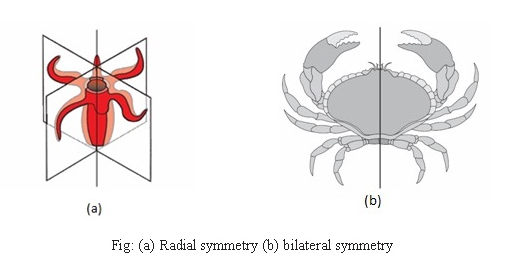
DIPLOBLASTIC & TRIPLOBLASTIC ORGANIZATION
Another basic feature of animals is the presence of two or more germ layers in the developing embryo.
Diploblastic organisms have two germ layers in the embryo – an internal endoderm and an external ectoderm. An undifferentiated layer called mesoglea is present between these layers. Eg: Coelenterates.
Triploblastic organisms have three germ layers in the embryo. A third layer called mesoderm is present between the internal endoderm and the external ectoderm.
Eg: All higher animals from Platyhelminthes to Chordates.
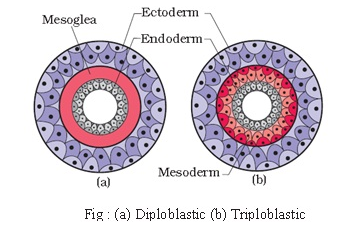
COELOM / BODY CAVITY
True coelom refers to the body cavity present between the body wall and the gut wall. It is formed by the splitting of mesoderm during embryonic development, and hence it is lined by mesodermal cells. All body organs are found within the coelom. Animals can be classified on the basis of presence or absence of this coelom.
Ascoelomates: Animals which do not possess coelom are called ascoelomates. Eg: Platyhelminthes.
Pseudocoelomates: In some animals, the coelom is interrupted by endodermal cells of alimentary canal. Hence, the coelom appears as small pouches and are found scattered between the ectoderm and endoderm. Such a coelom is called a pseudocoelom.
Eg: Aschelminthes.
Coelomates / Eucoelomates: Animals which possess true coelom are called coelomates. Eg: annelids, molluscs, arthropods, echinoderms,hemichordates and chordates.
- In sponges, the coelom is formed from blastocoel and is hence known as spongocoel.
- In coelenterates also the coelom is derived from blastocoel, and it is known as coelenteron.
- In arthropods, the coelom is known as haemocoel. It is highly reduced and is filled with haemolymph.
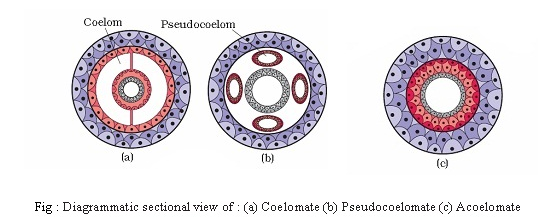
BODY SEGMENTATION
Body is unsegmented in animals like sponges, coelenterates and aschelminthes. In other animals, the body is divided internally and externally into segments. Sometimes, there will be a serial repetition of some organs.
The segmentation is called non–metameric when the new segments are added from the anterior end, and each segment is independent. Eg: Tapeworm.
In metameric segmentation, the segments are inter-dependent and new segments are added from the posterior end. Eg: Earthworm.
DEVELOPMENTAL PATTERN
Different variations are found during the embryonic development of an embryo. Animals are classified based on these variations.
Fertilization: If fertilization occurs outside the body, it is known as external fertilization (eg. Frog). In internal fertilization, fertilization occurs within the mother’s body (eg: Mammals).
Development of the embryo:
- In ovipary, eggs (fertilized or unfertilized) are laid. Development of embryo occurs within the eggs. Eg: Birds, Frogs.
- In vivipary, development of the embryo is completed within the mother’s body. Young ones are born after complete development. Eg: Mammals.
- In ovovivipary, the embryo develops within the mother’s body, but this development is not depended upon the body of the mother. Eg: Reptiles.
NOTOCHORD
The most important feature of animals is the presence or absence of a distinct notochord. It is a rod-shaped structure derived from mesoderm. It is found on the dorsal side of the animal.
Animals with notochord are called chordates.
Animals without notochord are called non–chordates.